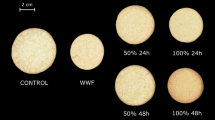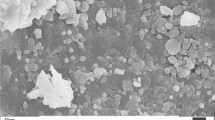Abstract
This study aims at understanding the relation among sprouting time (from 12 up to 72 h), changes in protein and starch components, and flour functionality in quinoa. Changes related to the activity of sprouting-related proteases were observed after 48 h of sprouting in all protein fractions. Progressive proteolysis resulted in relevant modification in the organization of quinoa storage proteins, with a concomitant increase in the availability of physiologically relevant metals such as copper and zinc. Changes in the protein profile upon sprouting resulted in improved foam stability, but in impaired foaming capacity. The increased levels of amylolytic enzymes upon sprouting also made starch less prompt to gelatinize upon heating. Consequently, starch re-association in a more ordered structure upon cooling was less effective, resulting in low setback viscosity. The nature and the intensity of these modifications suggest various possibilities as for using flour from sprouted quinoa as an ingredient in the formulation of baked products.



Similar content being viewed by others
Data Availability
n.a
References
Bastidas EG, Roura R, Rizzolo DAD, Massanés T, Gomis R (2016) Quinoa (Chenopodium quinoa Willd), from nutritional value to potential health benefits: an integrative review. J Nutr Food Sci 6:1–10. https://doi.org/10.4172/2155-9600.1000497
Friedman M (1996) Nutritional value of proteins from different food sources. A review J Agric Food Chem 44:6–29. https://doi.org/10.1021/jf9400167
Berti C, Ballabio C, Restani P, Porrini M, Bonomi F, Iametti S (2004) Immunochemical and molecular properties of proteins in Chenopodium quinoa. Cereal Chem 81:275–277. https://doi.org/10.1094/CCHEM.2004.81.2.275
Suárez-Estrella D, Torri L, Pagani MA, Marti A (2018) Quinoa bitterness: causes and solutions for improving product acceptability. J Sci Food Agric 98:4033–4041. https://doi.org/10.1002/jsfa.8980
Gómez-Caravaca AM, Iafelice G, Verardo V, Marconi E, Caboni MF (2014) Influence of pearling process on phenolic and saponin content in quinoa (Chenopodium quinoa Willd). Food Chem 157:174–178. https://doi.org/10.1016/j.foodchem.2014.02.023
Omary MB, Fong C, Rothschild J, Finney P (2012) Effects of germination on the nutritional profile of gluten-free cereals and pseudocereals: a review. Cereal Chem 89:1–14. https://doi.org/10.1094/CCHEM-01-11-0008
Elkhalifa AEO, Bernhardt R, Cardone G, Marti A, Iametti S, Marengo M (2017) Physicochemical properties of sorghum flour are selectively modified by combined germination-fermentation. J Food Sci Tech 54:3307–3313. https://doi.org/10.1007/s13197-017-2781-7
Marti A, Cardone G, Nicolodi A, Quaglia L, Pagani MA (2017) Sprouted wheat as an alternative to conventional flour improvers in bread-making. LWT-Food Sci Technol 80:230–236. https://doi.org/10.1016/j.lwt.2017.02.028
Cardone G, D'Incecco P, Pagani MA, Marti A (2020) Sprouting improves the bread-making performance of whole wheat flour (Triticum aestivum L.). J Sci Food Agric 100:2453–2459
Marengo M, Carpen A, Bonomi F, Casiraghi MC, Meroni E, Quaglia L, Iametti S, Pagani MA, Marti A (2017) Macromolecular and micronutrient profiles of sprouted chickpeas to be used for integrating cereal-based food. Cereal Chem 94:82–88. https://doi.org/10.1094/CCHEM-04-16-0108-FI
Mäkinen OE, Zannini E, Arendt EK (2013) Germination of oat and quinoa and evaluation of the malts as gluten free baking ingredients. Plant Foods Hum Nutr 68:90–95. https://doi.org/10.1007/s11130-013-0335-3
Hager AS, Mäkinen OE, Arendt EK (2014) Amylolytic activities and starch reserve mobilization during the germination of quinoa. Eur Food Res Technol 239:621–627. https://doi.org/10.1007/s00217-014-2258-0
Mäkinen OE, Hager AS, Arendt EK (2014) Localisation and development of proteolytic activities in quinoa (Chenopodium quinoa) seeds during germination and early seedling growth. J Cereal Sci 60:484–489. https://doi.org/10.1016/j.jcs.2014.08.009
AACC Approved Methods of Analysis (2001) Cereals & Grains Association. St. Paul, MN, USA
INEN (1988) Quinua. Determinación del contenido de saponinas por medio del método espumoso (método de rutina) (NTE INEN 1672). In: Registro Oficial del Ecuador N° 978, 1988
Koziol MJ (1991) Afrosimetric estimation of threshold saponin concentration for bitterness in quinoa (Chenopodium quinoa Willd). J Sci Food Agric 54:211–219. https://doi.org/10.1002/jsfa.2740540206
Marengo M, Bonomi F, Marti A, Pagani MA, Elkhalifa AEO, Iametti S (2015) Molecular features of fermented and sprouted sorghum flours relate to their suitability as components of enriched gluten-free pasta. LWT-Food Sci Technol 63:511–518. https://doi.org/10.1016/j.lwt.2015.03.070
Bradford MM (1976) A rapid and sensitive method for the quantitation of microgram quantities of protein utilizing the principle of protein-dye binding. Anal Biochem 72:248–254. https://doi.org/10.1016/0003-2697(76)90527-3
Coffmann CW, Garciaj VV (1977) Functional properties and amino acid content of a protein isolate from mung bean flour. Int J Food Sci 12:473–484. https://doi.org/10.1111/j.1365-2621.1977.tb00132.x
Rosa M, Hilal M, González JA, Prado FE (2004) Changes in soluble carbohydrates and related enzymes induced by low temperature during early developmental stages of quinoa (Chenopodium quinoa) seedlings. J Plant Physiol 161:683–689. https://doi.org/10.1078/0176-1617-01257
Moreno C, Seal CE, Papenbrock J (2018) Seed priming improves germination in saline conditions for Chenopodium quinoa and Amaranthus caudatus. J Agron Crop Sci 204:40–48. https://doi.org/10.1111/jac.12242
Grassi S, Cardone G, Bigagnoli D, Marti A (2018) Monitoring the sprouting process of wheat by non-conventional approaches. J Cereal Sci 83:180–187. https://doi.org/10.1016/j.jcs.2018.08.007
Ziegler P (1995) Carbohydrate degradation during seed development. In: Kigel J, Galili G (eds) Seed development and germination. Marcel Dekker Inc, New York, pp 447–474
Iametti S, Bonomi F, Pagani MA, Zardi M, Cecchini C, D'Egidio MG (2006) Properties of the protein and carbohydrate fractions in immature wheat kernels. J Agric Food Chem 54:10239–10244. https://doi.org/10.1021/jf062269t
Uluko H, Liu L, Lv JP, Zhang SW (2016) Functional characteristics of milk protein concentrates and their modification. Crit Rev Food Sci Nutr 56:1193–1208. https://doi.org/10.1080/10408398.2012.758625
Amagliani L, Scmitt C (2017) Globular plant protein aggregates for stabilization of food foams and emulsions. Trends Food Sci Technol 67:248–259. https://doi.org/10.1016/j.tifs.2017.07.013
Guo F, Xiong YL, Qin F, Jian H, Huang X, Chen J (2015) Surface properties of heat-induced soluble soy protein aggregates of different molecular masses. J Food Sci 80:C279–C287. https://doi.org/10.1111/1750-3841.12761
Mostafa MM, Rahma EH, Rady AH (1987) Chemical and nutritional changes in soybean during germination. Food Chem 23:257–275. https://doi.org/10.1016/0308-8146(87)90113-0
Jimenez D, Miraballes M, Gambaro A, Lobo M, Samman N (2020) Baby purees elaborated with Andean crops. Influence of germination and oils in physico-chemical and sensory characteristics. LWT-Food Sci Technol 124:108901. https://doi.org/10.1016/j.lwt.2019.108901
Acknowledgments
Diego Suárez-Estrella has been the grateful recipient of a PhD fellowship from Secretaría de Educación Superior, Ciencia, Tecnología e Innovación (SENESCYT), Ecuador. The authors thank professor Francesco Bonomi for fruitful discussion and for constructive criticism.
Author information
Authors and Affiliations
Corresponding authors
Ethics declarations
Conflict of Interest
The authors declare no conflict of interest.
Ethics Approval
n.a
Consent to Participate
n.a
Consent for Publication
n.a
Code Availability
n.a
Additional information
Publisher’s Note
Springer Nature remains neutral with regard to jurisdictional claims in published maps and institutional affiliations.
Electronic supplementary material
ESM 1
(DOCX 16 kb)
Rights and permissions
About this article
Cite this article
Suárez-Estrella, D., Bresciani, A., Iametti, S. et al. Effect of Sprouting on Proteins and Starch in Quinoa (Chenopodium quinoa Willd.). Plant Foods Hum Nutr 75, 635–641 (2020). https://doi.org/10.1007/s11130-020-00864-6
Accepted:
Published:
Issue Date:
DOI: https://doi.org/10.1007/s11130-020-00864-6




